The order Piciformes is made up of the woodpecker family Picidae plus 8 other families. Picidae make up about half of the species. In general, the Piciformes are insectivorous, but some exceptions eat mostly fruit. Nearly all Piciformes have parrot-like feet—two toes forward and two back, an arrangement that has obvious advantages for birds that spend much of their time on tree trunks. And most Piciformes do not have down feathers at any age, only true feathers. All nest in cavites.
Family Lybiidae: African Barbets
There are three barbet families: Capitonidae (New World), Lybiidae (African), and Megalaimidae (Asian). This article describes the African barbets.
The family Lybiidae is comprised of the African barbets. They are found throughout most of sub-Saharan Africa. They are plump-looking, with large heads and a heavy bill which is fringed with bristles. Tinkerbirds, the smallest African barbets, are between 9 and 12 cm of length. Genus Lybius has the largest barbets, with the black-breasted barbet reaching 27 cm long. They mainly eat fruits and seeds, but insects are also an important food source. Some barbets will also eat small vertebrates. Fruit is eaten whole and indigestible material such as seed pits regurgitated later. Prey is often beat against a branch or other object before being eaten. African barbets are quite similar to the American barbets which also belong to Piciformes.
Genus Buccanodon - 1 species
Barbet,_Yellow-spotted Buccanodon duchaillui
Description: The yellow-spotted barbet is sometimes split into two species: eastern yellow-spotted barbet (Buccanodon duchaillui) and western yellow-spotted barbet (Buccanodon dowsetti). The both have black upperparts with yellow spots, a black bib, black bill, red forehead and fore-crown, and a yellow supercilium. The underparts are yellow with black barring, with the western subspecies have blacker underparts than the eastern.
Range: East Africa (Buccanodon duchaillui) and west Africa (Buccanodon dowsett)
Habitat: Fruits, insects such as termites.
Diet: Forest plus their edges and clearings, tree plantations.
Conservation status: Least Concern.
Image by: 1) Dick Daniels - specimen in Nairobi National Museum, Kenya 2) Dave Curtis - Kenya 3) Nik_Borrow - UgandaRange: East Africa (Buccanodon duchaillui) and west Africa (Buccanodon dowsett)
Habitat: Fruits, insects such as termites.
Diet: Forest plus their edges and clearings, tree plantations.
Conservation status: Least Concern.

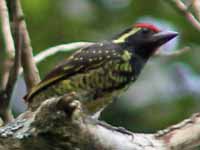
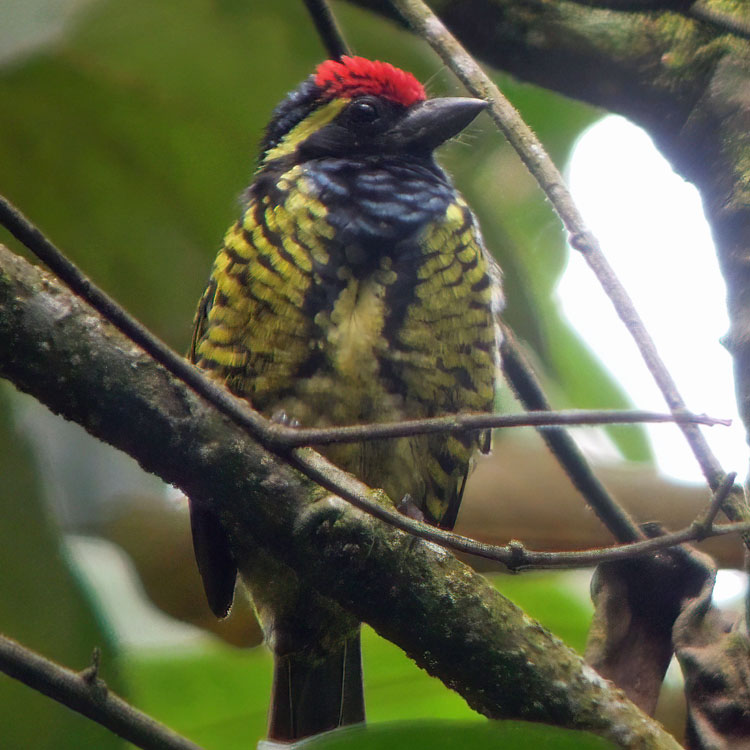
Genus Gymnobucco
These four species of African barbets are all about 17 cm long. They are usually colonial breeders.
Barbet,_Bristle-nosed Gymnobucco peli
Description: The bristle-nosed barbet has brown upperparts. The dark grey head has bristles around the base of the bill. The underparts are yellowish brown. The bristle-nosed barbet is 17 cm long and about 50 grams.
Range: Central Africa and southeastern Africa.
Habitat: Forests near fruit trees.
Diet: Mainly fruits; also insects.
Conservation status: Least Concern.
Image by: 1) Ross Tsai 2) Francesco_Veronesi - GhanaRange: Central Africa and southeastern Africa.
Habitat: Forests near fruit trees.
Diet: Mainly fruits; also insects.
Conservation status: Least Concern.

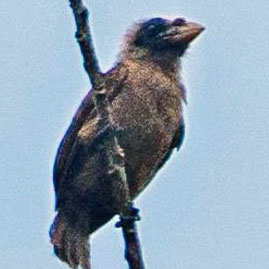
Barbet,_Grey-throated Gymnobucco bonapartei
Description: The grey-throated barbet has mainly brown plumage. The head and throat are grey. The grey-throated barbet is about 17 cm long. It is a social breeder, usually with more than one cavity nest in a tree.
Range: Central Africa.
Habitat: Forests and other locations near fruit trees
Diet: Fruits, insects and their larvae.
Conservation status: Least Concern.
Image by: 1) Nik_Borrow - Kenya 2) Steve_Garvie - Kenya 3) Peter_Steward - KenyaRange: Central Africa.
Habitat: Forests and other locations near fruit trees
Diet: Fruits, insects and their larvae.
Conservation status: Least Concern.

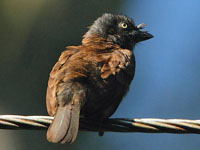
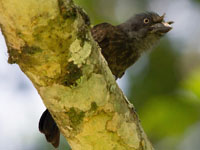
Barbet,_Naked-faced Gymnobucco calvus
Description: The naked-faced barbet has dark brown underparts with a few pale streaks. The bare face is blue-grey, the bill is pale, and the underparts are light brown. The naked-faced barbet is about 17 cm long. It is usually a colonial breeder.
Range: West central Africa.
Habitat: Various forests; requires dead trees for nests and nearby fruit trees.
Diet: Fruits. Able to capture insects in the air.
Conservation status: Least Concern.
Image by: 1) John_Gerrard_Keulemans 2) Nik_BorrowRange: West central Africa.
Habitat: Various forests; requires dead trees for nests and nearby fruit trees.
Diet: Fruits. Able to capture insects in the air.
Conservation status: Least Concern.

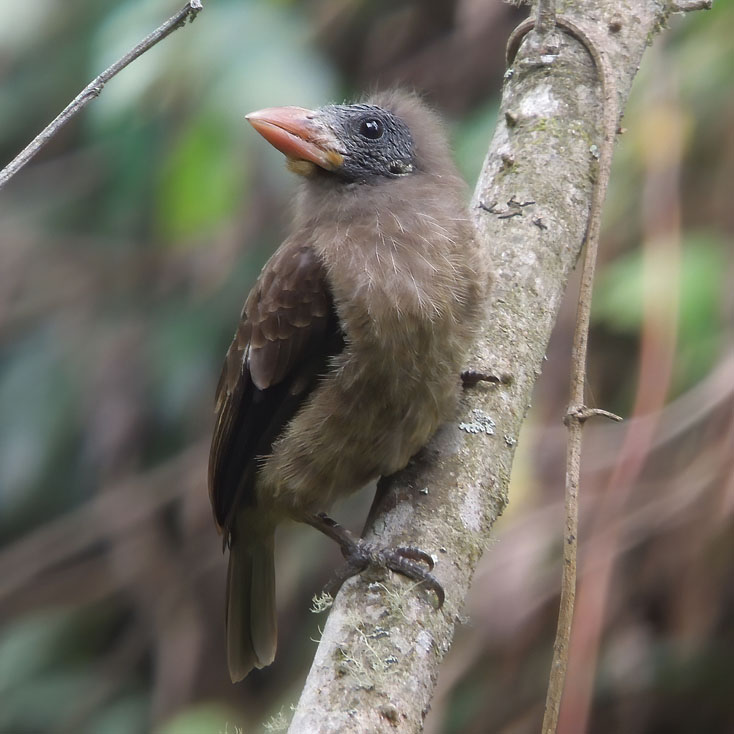
Barbet,_Sladen's Gymnobucco sladeni
Description: The Sladen's barbet has dark brown upperparts and lighter brown underparts. It has a bluish-grey bare face with tufts of bristles at the base of the bill. It is usually a colonial breeder. The Sladen's barbet is about 17 cm long. The similar bristle-nosed barbet has less streaky plumage.
Range: Central African Republic, DR Congo.
Habitat: Forest.
Diet: Mainly fruits, also insects.
Conservation status: Least Concern.
Range: Central African Republic, DR Congo.
Habitat: Forest.
Diet: Mainly fruits, also insects.
Conservation status: Least Concern.
Genus Lybius
Their plumage is mainly black, white, and red; their diet is mainly fruit and insects. They nest are in tree cavities.
Barbet,_Banded Lybius undatus
Description: The banded barbet has a black upper-mantle, head, and breast. There is a white line starting behind the eye and heading towards the shoulder. It has a red forehead and fore-crown. The lower mantle and beyond are black with white barring and the pale underparts also have barring. It has reddish-yellow eyes. The banded barbet is about 17 cm long.
Range: Eritrea, Ethopia.
Habitat: Trees near water.
Diet: Fruits. Gleans and flycatches insects.
Conservation status: Least Concern.
Image by: 1) Kris Maes 2) Rafael_Medina - Ethiopia 3) Nik_Borrow - EthiopiaRange: Eritrea, Ethopia.
Habitat: Trees near water.
Diet: Fruits. Gleans and flycatches insects.
Conservation status: Least Concern.
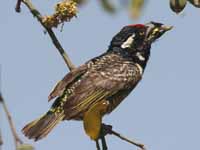
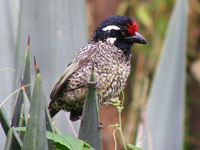
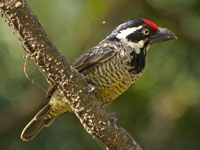
Barbet,_Bearded Lybius dubius
Description: The bearded barbet has black upperparts, head, tail, and breast band. It also has black throat whiskers (hence its name). The bearded barbet has a red throat, red upper-breast, a yellow eye patch, and a yellow massive bill. Its white belly often has red stains. The bearded barbet is 26 cm long and weighs 80 to 110 grams.
Range: Tropical west Africa.
Habitat: Well-wooded areas with plentiful fig trees; also more open areas with fruit trees.
Diet: Fruit; probably also insects.
Conservation status: Least Concern.
Image by: 1) Leszek Leszczynski - Warsaw Zoo, Poland 2) Nik_Borrow - Ghana 3) Doug Zwick - Calgary Zoo, Canada Range: Tropical west Africa.
Habitat: Well-wooded areas with plentiful fig trees; also more open areas with fruit trees.
Diet: Fruit; probably also insects.
Conservation status: Least Concern.

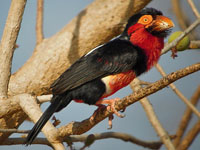
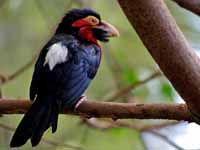
Barbet,_Black-backed Lybius minor
Description: The black-backed barbet, also known as white-faced barbet, has blackish upperparts. It has a red forehead, red fore-crown, and black lores. The face is white (except L. m. minor) as are the underparts except for some pink on the belly. The black-backed barbet is about 20 cm long.
Range: South-central Africa.
Habitat: Forest edges, open country with trees available.
Diet: Fruit, insects (especially flying).
Conservation status: Least Concern.
John Gerrard Keulemans 2) Nigel_Voaden - DR CongoRange: South-central Africa.
Habitat: Forest edges, open country with trees available.
Diet: Fruit, insects (especially flying).
Conservation status: Least Concern.
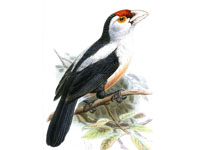
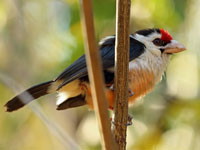
Barbet,_Black-billed Lybius guifsobalito
Description: The black-billed barbet has mainly blue-black plumage with the wings and belly having a brown tinge. The face, throat and upper-breast are red, the eyes reddish-brown, and the large bill is black. The black-billed barbet is about 17 cm long.
Range: Africa.
Habitat: Open forests, forest edges, woodland vegetation, savannah, scrubs.
Diet: Mainly fruit and berries. Also, insects such as ants and locust.
Conservation status: Least Concern.
Image by: 1) Hectonichus - museum specimen 2, 3) Nik_Borrow - Ethiopia 4) Brian Henderson - EthiopiaRange: Africa.
Habitat: Open forests, forest edges, woodland vegetation, savannah, scrubs.
Diet: Mainly fruit and berries. Also, insects such as ants and locust.
Conservation status: Least Concern.
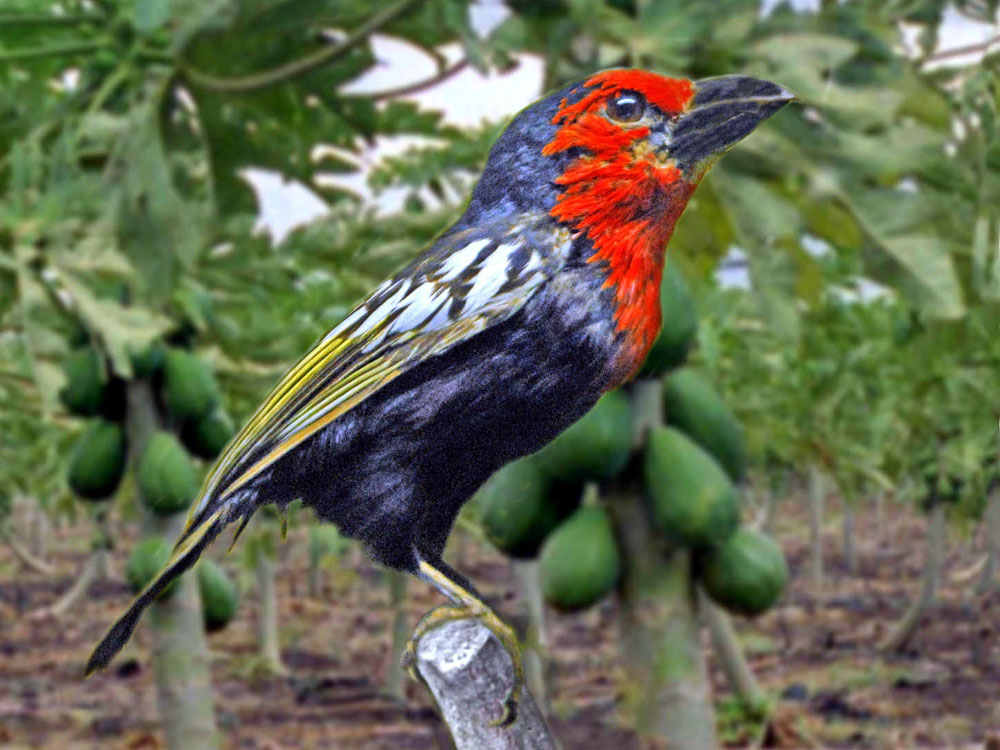
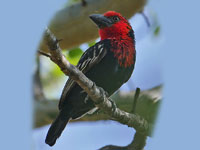
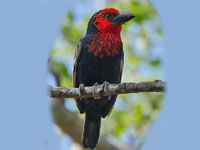
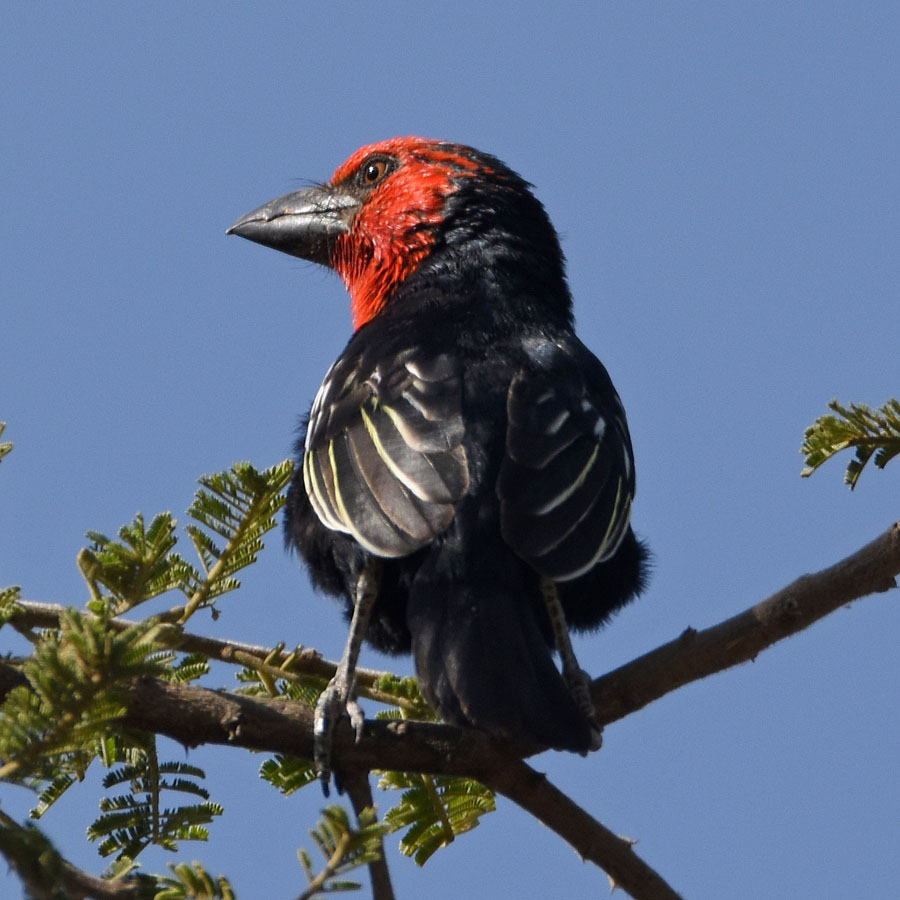
Barbet,_Black-breasted Lybius rolleti
Description: The black-breasted barbet has mainly black plumage. There is a white back patch and a white belt with a red swarth. It has a massive ivory bill. The black-breasted barbet is 27 cm long and weighs 95 to 105 grams.
Range: Central African Republic, Chad, Sudan, and Uganda.
Habitat: Woodlands, areas with scattered trees.
Diet: Fruits; also insects.
Conservation status: Least Concern.
Image by: 1) Gossip_Guy 2) Nik_Borrow - UgandaRange: Central African Republic, Chad, Sudan, and Uganda.
Habitat: Woodlands, areas with scattered trees.
Diet: Fruits; also insects.
Conservation status: Least Concern.
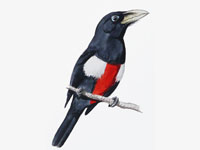

Barbet,_Black-collared Lybius torquatus Found: Africa
Description: The black-collared barbet has mainly brown upperparts, a black nape and collar. The rest of the head and neck are red. It has a black breast-band with the rest of the underparts pale yellow. The black-collared barbet is 18 cm long.
Range: Sub-Saharan Africa.
Habitat: Woodlands, areas with scattered trees.
Diet: Mainly fruits; also insects.
Conservation status: Least Concern.
Image by: 1) Dave Govoni - Botswana 2) Steve Evans - South Africa 3) Bernard Dupont - South AfricaRange: Sub-Saharan Africa.
Habitat: Woodlands, areas with scattered trees.
Diet: Mainly fruits; also insects.
Conservation status: Least Concern.
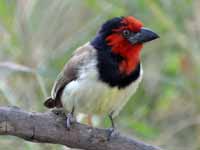
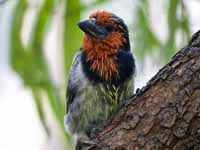

Barbet,_Brown-breasted Lybius melanopterus
Description: The brown-breasted barbet has mainly black upperparts with white edging and a white patch in the middle of its back. It has a red forehead, face, and neck. The breast is brown and the belly is white. The brown-breasted barbet is 19 cm long and weighs 45 to 60 grams.
Range: Kenya, Malawi, Mozambique, Somalia, and Tanzania.
Habitat: Woodlands, areas with scattered trees.
Diet: Fruits, insects. It can catch insects by in the air.
Conservation status: Least Concern.
Image by: 1) Venk - Hamburg Zoo 2, 3) Nik_Borrow - TanzaniaRange: Kenya, Malawi, Mozambique, Somalia, and Tanzania.
Habitat: Woodlands, areas with scattered trees.
Diet: Fruits, insects. It can catch insects by in the air.
Conservation status: Least Concern.
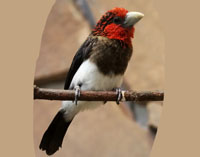

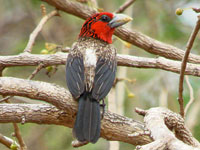
Barbet,_Chaplin's Lybius chaplini
Description: The Chaplin's barbet has mainly white plumage. It does have a black tail and black wings with yellow edges. The head is large, the bill heavy with bristles, and there is red around the eyes.The Chaplin's barbet is 19 cm long and 65 to 75 grams.
Range: Zambia.
Habitat: Open woodland areas where figs are abundant.
Diet: Fruit, insects.
Conservation status: Least Concern.
Image by: 1) P_Khoo 2, 3) Nik_Borrow - ZambiaRange: Zambia.
Habitat: Open woodland areas where figs are abundant.
Diet: Fruit, insects.
Conservation status: Least Concern.


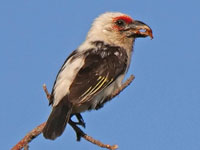
Barbet,_Double-toothed Lybius bidentatus
Description: The double-toothed barbet has black upperparts with a white patch on the back. The underparts are mainly red with white flanks. It also has a red face. It has a yellow eye-ring which continues slightly past the eye. The double-toothed barbet is 23 cm log.
Range: Central Africa.
Habitat: Forest and their edges and clearing. More open areas with trees available.
Diet: Fruit, insects, larvae.
Conservation status: Least Concern.
Image by: 1, 2) Nik_Borrow - Ethiopia 3) Nathan Rupert - San Diego Zoo 4) Steve Garvie - KenyaRange: Central Africa.
Habitat: Forest and their edges and clearing. More open areas with trees available.
Diet: Fruit, insects, larvae.
Conservation status: Least Concern.

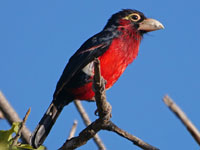


Barbet,_Red-faced Lybius rubrifacies
Description: The red-faced barbet has mainly black plumage. It has a red face and yellow streaked wings. The red-faced barbet is 18 cm long.
Range: Burundi, Rwanda, Northwest Tanzania, and Southwest Uganda.
Habitat: Woodland, grasslands with trees available.
Diet: Fruits, especially figs. Also insects which it captures by gleaning or on the wing.
Conservation status: It is listed as Near Threatened due to its small range and corresponding small population.
Image by: 1) Andrea Schieber 2, 3) Nik_Borrow - UgandaRange: Burundi, Rwanda, Northwest Tanzania, and Southwest Uganda.
Habitat: Woodland, grasslands with trees available.
Diet: Fruits, especially figs. Also insects which it captures by gleaning or on the wing.
Conservation status: It is listed as Near Threatened due to its small range and corresponding small population.

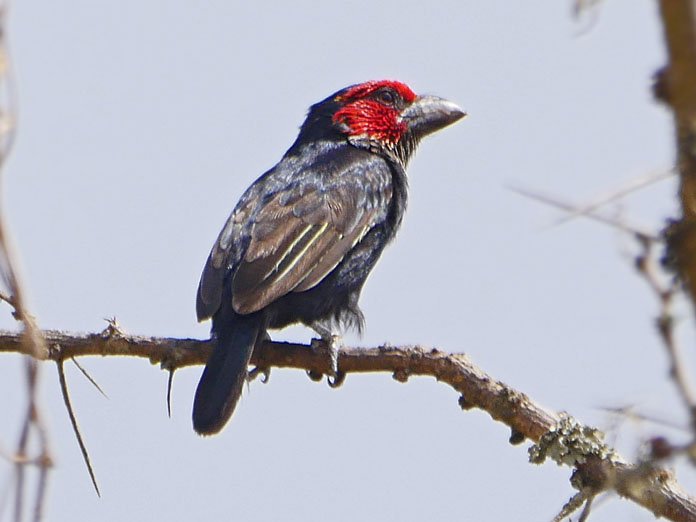
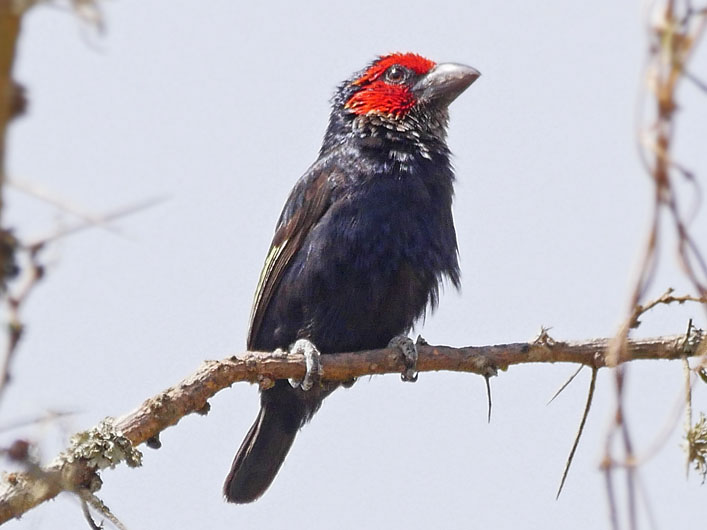
Barbet,_White-headed Lybius leucocephalus
Description: The white-headed barbet has white a head, neck, breast, and tail; the rest is black. The white-headed barbet is about 19 cm long. They are very social and live in small groups.
Range: Central Africa.
Habitat: Open woodland areas that are close to water and cultivation.
Diet: Fruit and insects.
Conservation status: Least Concern.
Image by: 1) David Bygott - Tanzania 2) Nigel_Voaden - Tanzania 3) Francesco_Veronesi - Kenya 4) Nik_Borrow - UgandaRange: Central Africa.
Habitat: Open woodland areas that are close to water and cultivation.
Diet: Fruit and insects.
Conservation status: Least Concern.
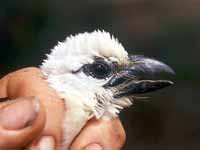

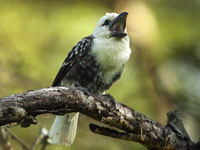
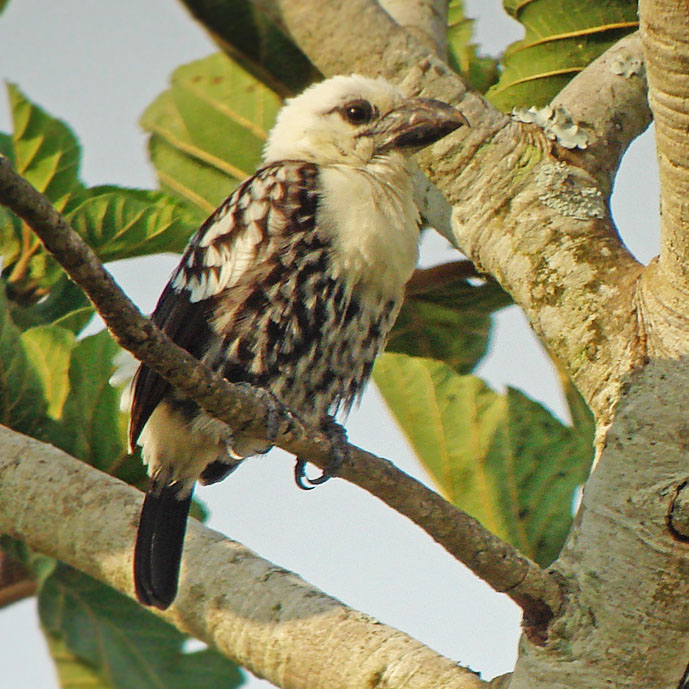
Barbet,_Viellot's Lybius vieilloti
Description: The Viellot's barbet has brown upperparts with a yellow stripe down the back. It has a red head. The neck and breast are red, the thick bill is grey. It has a yellowish belly with dark flank spotting. The Viellot's barbet is about 16 cm long.
Range: Southern edge of Sahara Desert from Senegal to Ethiopia.
Habitat: Savanna and farmland with trees available.
Diet: Fruit and insects.
Conservation status: Least Concern.
Image by: 1) Francesco_Veronesi - Gambia 2) Allan_Hopkins - GambiaRange: Southern edge of Sahara Desert from Senegal to Ethiopia.
Habitat: Savanna and farmland with trees available.
Diet: Fruit and insects.
Conservation status: Least Concern.
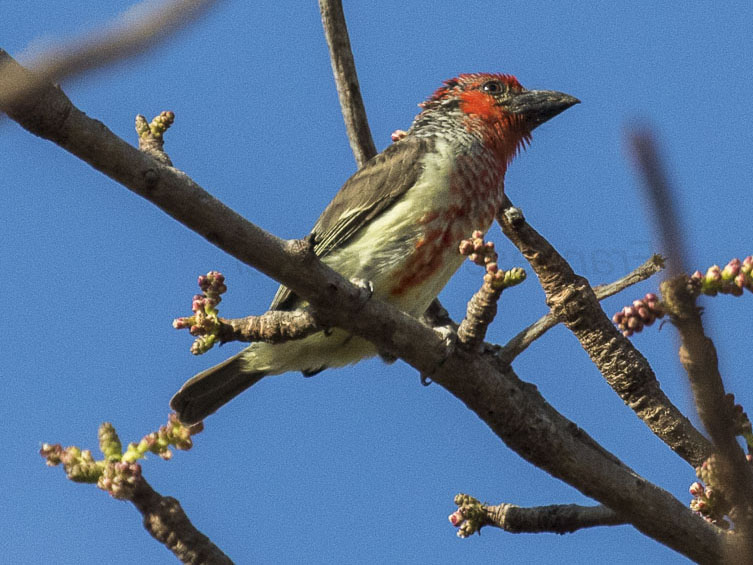
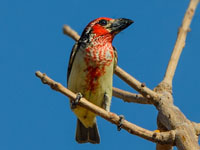
Genus Pogoniulus
Tinkerbirds are found in Tropical Africa. They vary in length from 9 t0 12 cm. Unlike the larger barbets, the tinkerbirds sing from cover and are more frequently heard than seen. The name stems from the fast tink-tink calls. They nest in cavities which they excavate in dead wood, be it tree trunks or branches.
Tinkerbird,_Green Pogoniulus simplex
Description: The green tinkerbird, also known as eastern green tinkerbird, has olive-green upperparts with yellow and blackish wings. The underparts are pale greyish yellow. The green tinkerbird is 9 cm long.
Range: Kenya, Malawi, Mozambique, Tanzania.
Habitat: Forest undergrowth, forest edges.
Diet: Mainly fruit. Also insects which it captures by gleaning.
Conservation status: Least Concern.
Image by: 1) Steve_Garvie - Kenya 2) Nik_Borrow - TanzaniaRange: Kenya, Malawi, Mozambique, Tanzania.
Habitat: Forest undergrowth, forest edges.
Diet: Mainly fruit. Also insects which it captures by gleaning.
Conservation status: Least Concern.
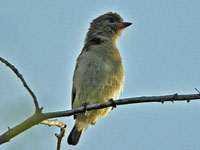
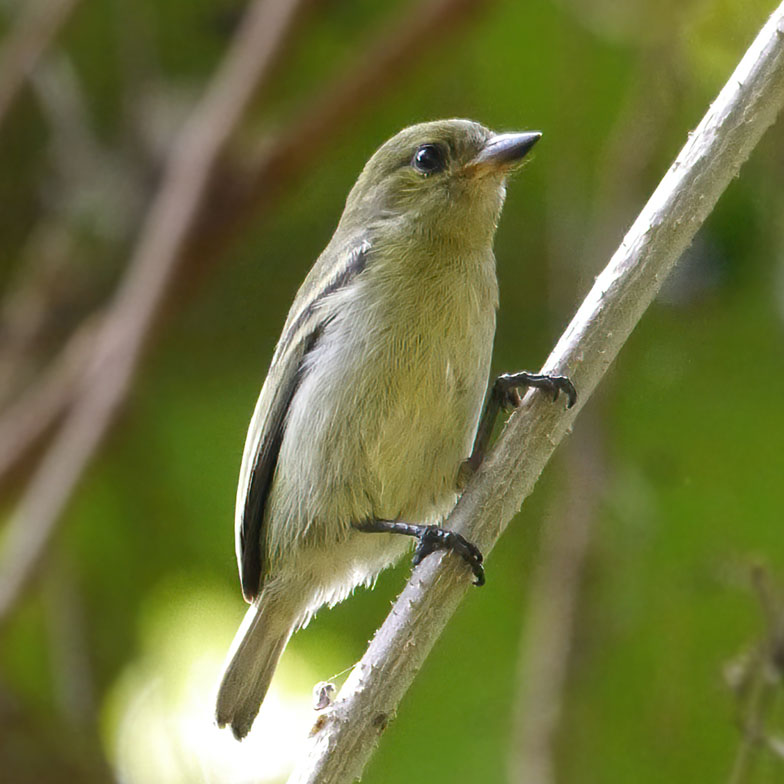
Tinkerbird,_Moustached Pogoniulus leucomystax
Description: The moustached tinkerbird is dark green upperparts with a distinctive yellow rump, The wings are black with a yellow wingbar. It has a white malar stripe and a black tail. The underparts are pale yellowish-grey. The moustached tinkerbird is 9.5 cm long
Range: Kenya, Malawi, Tanzania, Uganda, and Zambia.
Habitat: Forest undergrowth, forest edges. Usually prefers dense undergrowth and in montane locations.
Diet: Mainly fruit and berries with a preference for mistletoe berries. Also insects.
Conservation status: Least Concern.
Image by: 1, 2) David Bygott - Tanzania 3) Peter_Steward - Kenya Range: Kenya, Malawi, Tanzania, Uganda, and Zambia.
Habitat: Forest undergrowth, forest edges. Usually prefers dense undergrowth and in montane locations.
Diet: Mainly fruit and berries with a preference for mistletoe berries. Also insects.
Conservation status: Least Concern.
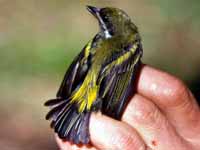

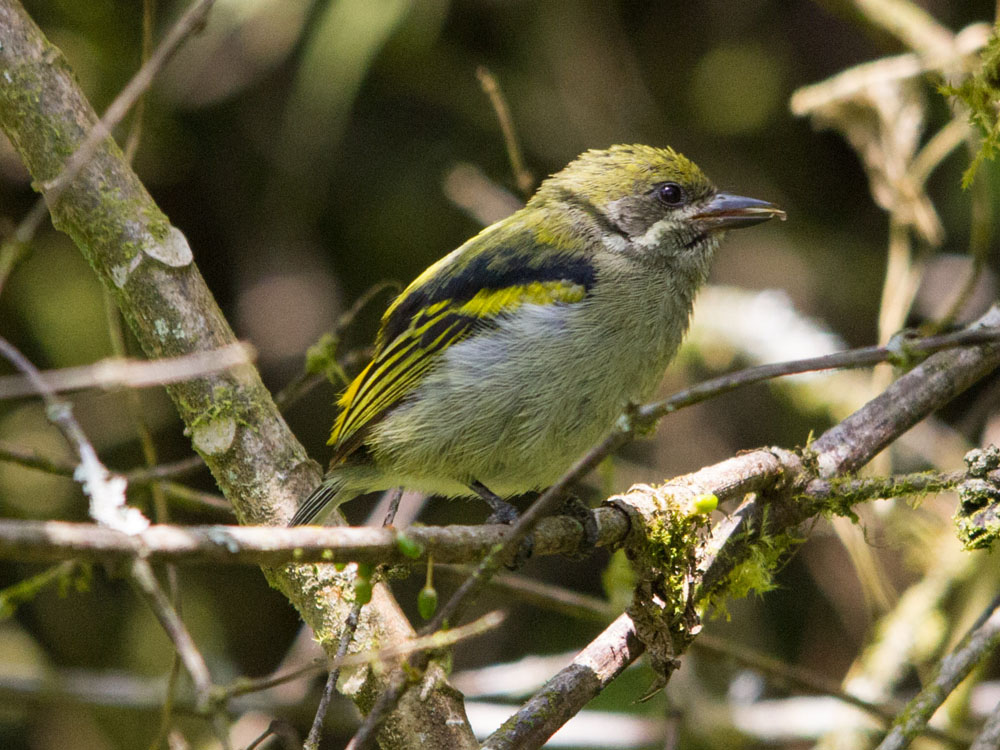
Tinkerbird,_Red-fronted Pogoniulus pusillus
Description: The red-fronted tinkerbird has black upperparts which are heavily streaked with yellow and white. It has a golden wing patch, a black and white patterned head with a red forehead patch. The underparts are pale. The red-fronted tinkerbird is 9 to 11 cm long.
Range: East Africa and also south Africa.
Habitat: Juniper forest and scrub.
Diet: Mainly fruit and berries with a preference for mistletoe berries. Also insects.
Conservation status: Least Concern.
Image by: 1) Clive Reid - South Africa 2) Carol Foil - Kenya 3) Alan_Manson - South Africa 4) Nik Borrow - EthiopiaRange: East Africa and also south Africa.
Habitat: Juniper forest and scrub.
Diet: Mainly fruit and berries with a preference for mistletoe berries. Also insects.
Conservation status: Least Concern.

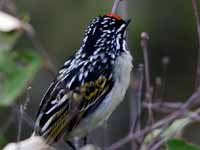

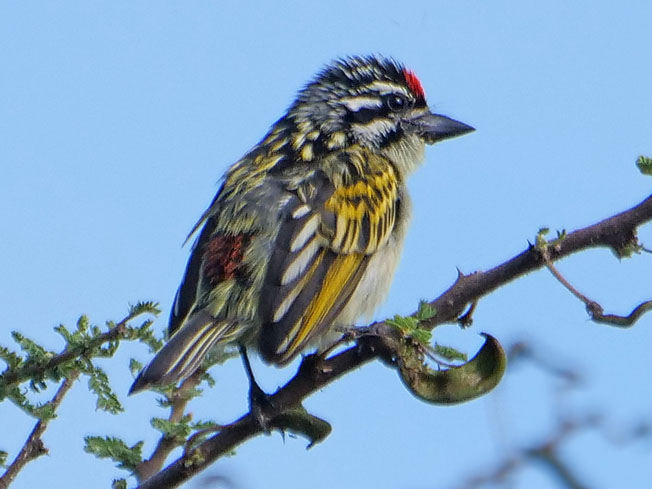
Tinkerbird,_Red-rumped Pogoniulus atroflavus
Description: The red-rumped tinkerbird has black upperparts with yellow wingbar and red rump. There are 2 yellow stripes near the eye plus a yellow malar stripe. It has a yellow throat and pale greyish underparts. The red-rumped tinkerbird is about 12 cm long which is large for a tinkerbird.
Range: West-central Africa.
Habitat: Wooded areas and their edges; treed grasslands.
Diet: Mainly fruit with figs a favorite; also insects.
Conservation status: Least Concern.
Image by: 1) Francesco_Veronesi - Ghana 2, 3, 4) Nik Borrow - GhanaRange: West-central Africa.
Habitat: Wooded areas and their edges; treed grasslands.
Diet: Mainly fruit with figs a favorite; also insects.
Conservation status: Least Concern.
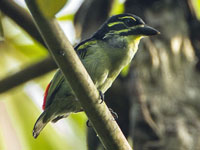


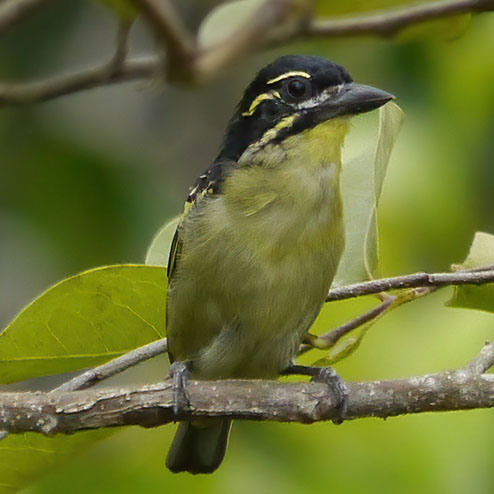
Tinkerbird,_Speckled Pogoniulus scolopaceus
Description: The speckled tinkerbird has dark grey upperparts with yellowish edging producing a speckled appearance. The underparts are pale buff. It is about 12 cm long which is long for a tinkerbird. Excavates nest cavity in dead wood.
Range: Central Africa.
Habitat: Forest edges and clearings,
Diet: Fruit and insects.
Conservation status: Least Concern.
Image by: 1) Francesco_Veronesi - Ghana 2) Nik_Borrow - LiberiaRange: Central Africa.
Habitat: Forest edges and clearings,
Diet: Fruit and insects.
Conservation status: Least Concern.

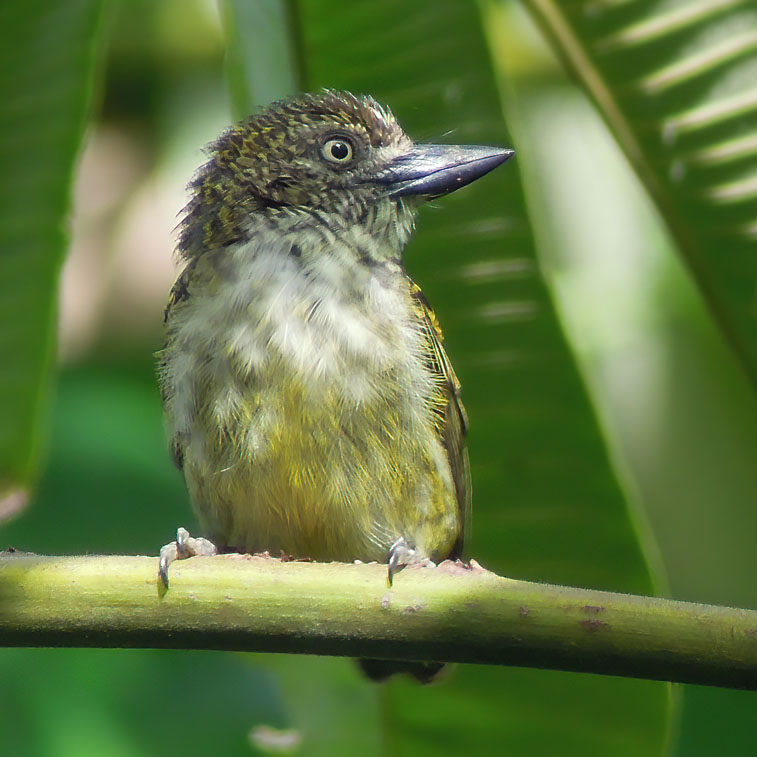
Tinkerbird,_Western Pogoniulus coryphaea
Description: The western tinkerbird has black upperparts with a yellow band from forehead to rump and also yellow wingbars. It has a white malar stripe and greyish-olive underparts. The western tinkerbird is 9 to 10 cm long.
Range: Cameroon, DR Congo, Nigeria, Rwanda, and Uganda.
Habitat: Undergrowth of montane forests, forest edges and clearings.
Diet: Fruits (especially figs) and berries (especially mistletoe). Also insects.
Conservation status: Least Concern.
Image by: 1) Aviceda 2, 3) Nik_Borrow - UgandaRange: Cameroon, DR Congo, Nigeria, Rwanda, and Uganda.
Habitat: Undergrowth of montane forests, forest edges and clearings.
Diet: Fruits (especially figs) and berries (especially mistletoe). Also insects.
Conservation status: Least Concern.
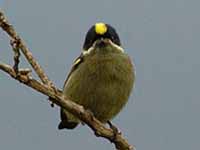

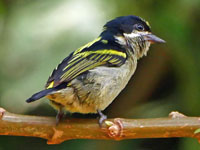
Tinkerbird,_Yellow-fronted Pogoniulus chrysoconus
Description: The yellow-fronted tinkerbird has black upperparts which are heavily streaked with yellow and white. Its black and white patterned head has a yellow forehead patch. The underparts are pale yellowish. The yellow-fronted tinkerbird is about 11 cm long.
Range: Sub-Saharan Africa.
Habitat: Open to closed broadleaved or mixed woodlands and scrub.
Diet: Fruit, berries, and insects. Favors mistletoe berries.
Conservation status: Least Concern.
Image by: 1) Ian White - Namibia 2) Arno Meintjes 3) JV Verde - Gambia 4) Derek_Keats - South AfricaRange: Sub-Saharan Africa.
Habitat: Open to closed broadleaved or mixed woodlands and scrub.
Diet: Fruit, berries, and insects. Favors mistletoe berries.
Conservation status: Least Concern.


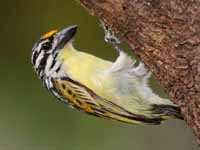

Tinkerbird,_Yellow-rumped Pogoniulus bilineatus
Description: The yellow-rumped tinkerbird has black upperparts with yellow edges to the wings. It has a white supercilium and white malar stripe. The throat is white transitioning to a yellow belly and rump. The yellow-rumped tinkerbird is 10 to 12 cm long.
Range: Sub-Saharan Africa.
Habitat: Forest edges and clearings, thickets.
Diet: Fruit, berries, and insects. Favors mistletoe berries.
Conservation status: Least Concern.
Image by: 1) Arno Meintjes 2) Nik_Borrow - Uganda 3) Ngaiognome - South Africa 4) Nathan Rupert - San Diego Zoo Range: Sub-Saharan Africa.
Habitat: Forest edges and clearings, thickets.
Diet: Fruit, berries, and insects. Favors mistletoe berries.
Conservation status: Least Concern.

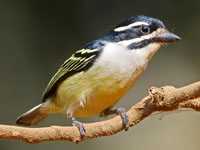
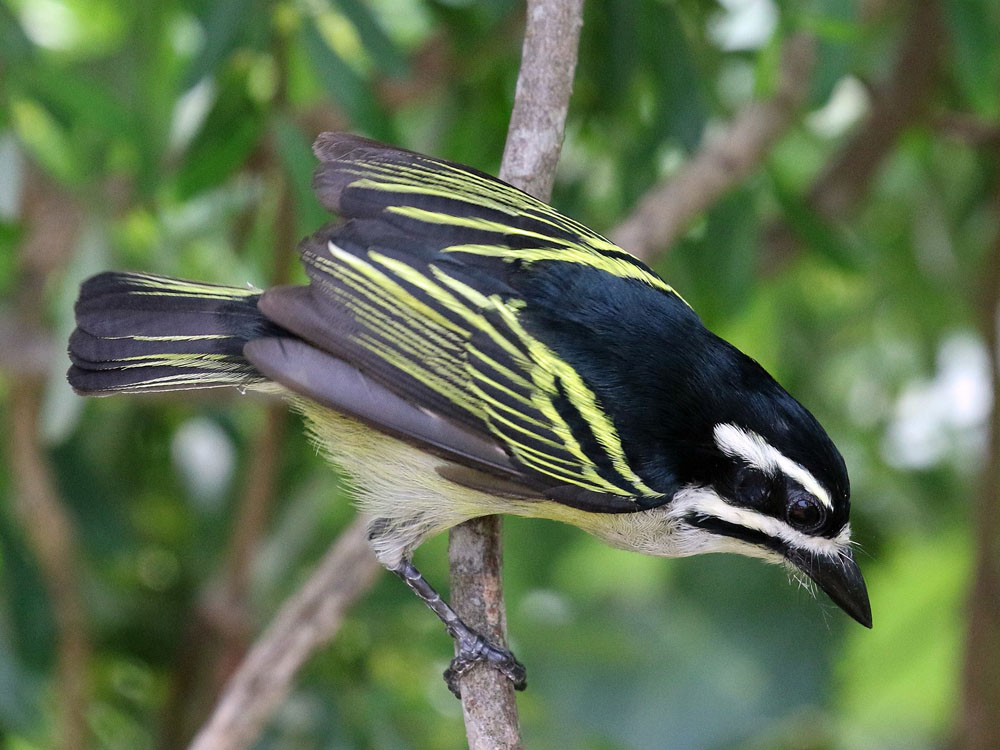
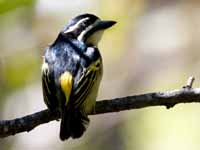
Tinkerbird,_Yellow-throated Pogoniulus subsulphureus
Description: The yellow-throated tinkerbird has mainly black upperparts. It has a white or yellow eye-line and a white malar stripe, The flight feathers have yellowish edges. The underparts are white with a yellow throat in some subspecies. The yellow-throated tinkerbird is 9.5 cm long.
Range: Central Africa.
Habitat: Forest edges and clearings, treed grasslands.
Diet: Fruit and insects.
Conservation status: Least Concern.
Image by: 1) Peter_Steward - Uganda 2, 3,) Nik_Borrow - Uganda, CameroonRange: Central Africa.
Habitat: Forest edges and clearings, treed grasslands.
Diet: Fruit and insects.
Conservation status: Least Concern.
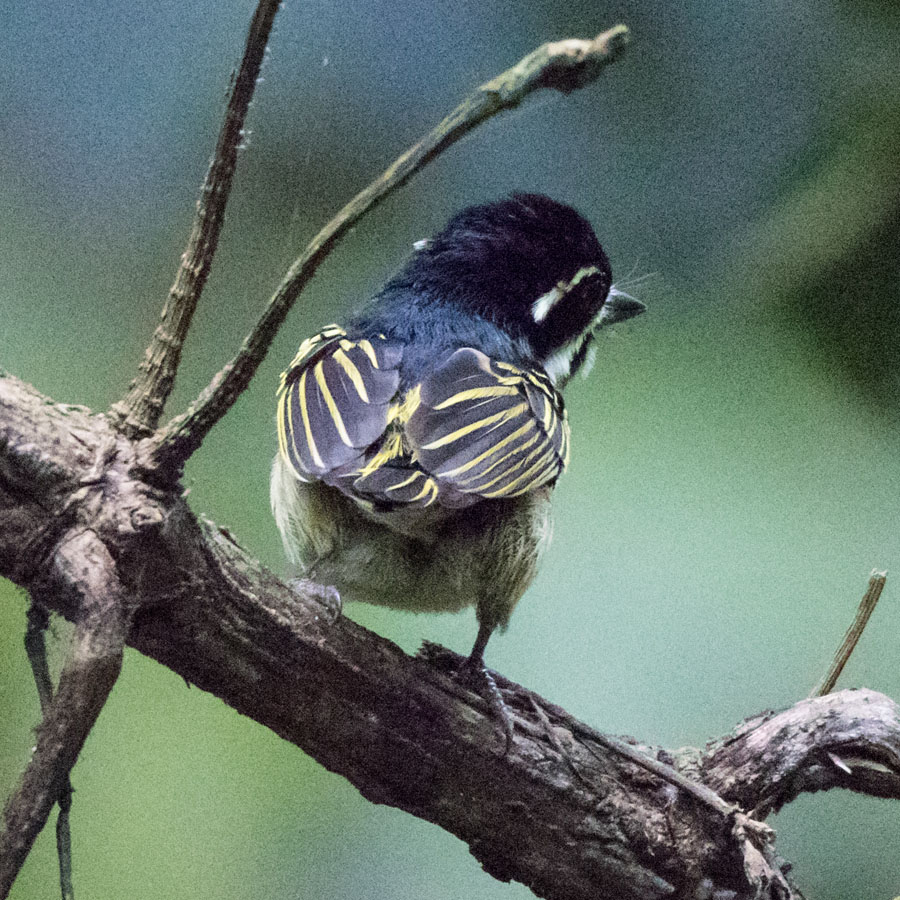
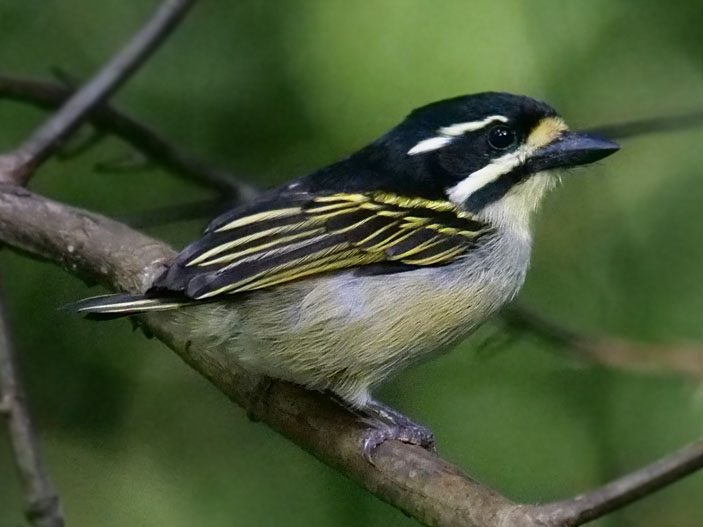
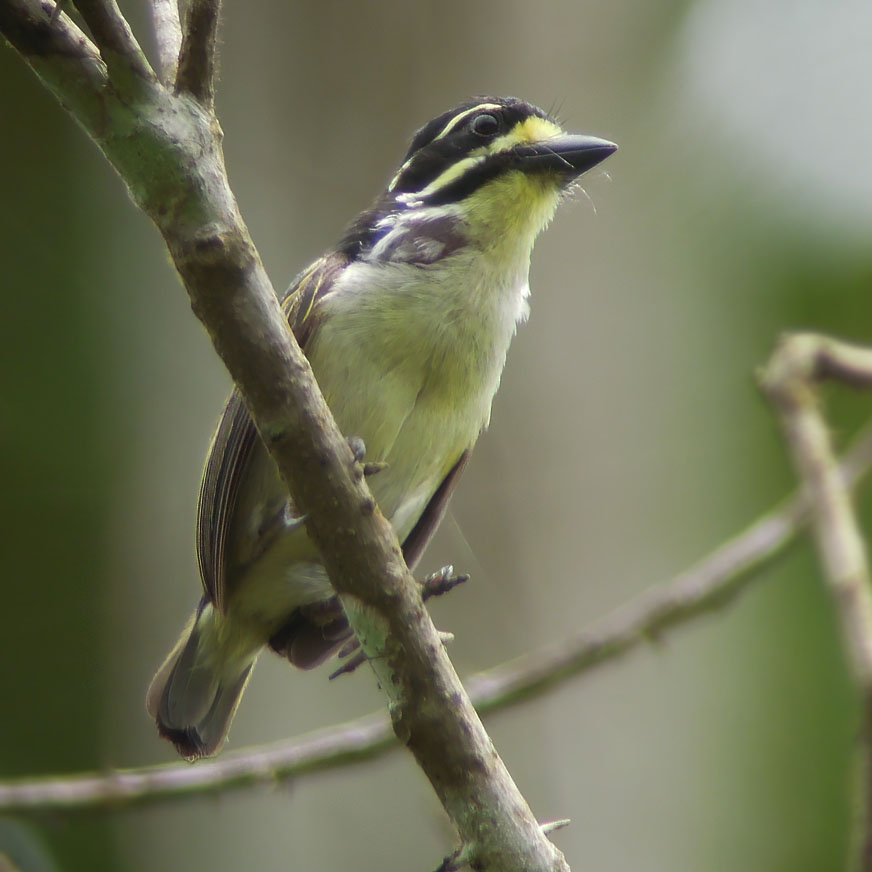
Genus Stactolaema
These African barbets are cooperative breeders. Helpers participate during nest excavation in dead wood of tree trunks or branches and in keeping the nest clean. They are medium sized African barbets, 17 to 20 cm long.
Barbet,_Anchieta's Stactolaema anchietae
Image by: 1) John Gerrard Keulemans 2) Maans Booysen - Angola

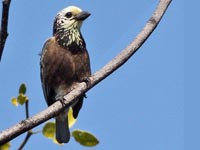
Barbet,_Green Stactolaema olivacea
Description: The green barbet has dull olive-green upperparts, a dark brown head and chin, dull red to orange eyes, and a black bill. Some races have yellow ear-coverts. There is yellow on the wing and the underparts are pale green. It is social during foraging and roosting. The green barbet is 17 to 18 cm long.
Range: Kenya, Tanzania, Malawi, Mozambique and South Africa.
Habitat: Forest, both dense and open. Usually found near fig trees.
Diet: Fruits, especially figs. Also insects.
Conservation status: Least Concern.
Image by: 1, 3) Derek_Keats - South Africa 2) Steve Garvie - KenyaRange: Kenya, Tanzania, Malawi, Mozambique and South Africa.
Habitat: Forest, both dense and open. Usually found near fig trees.
Diet: Fruits, especially figs. Also insects.
Conservation status: Least Concern.
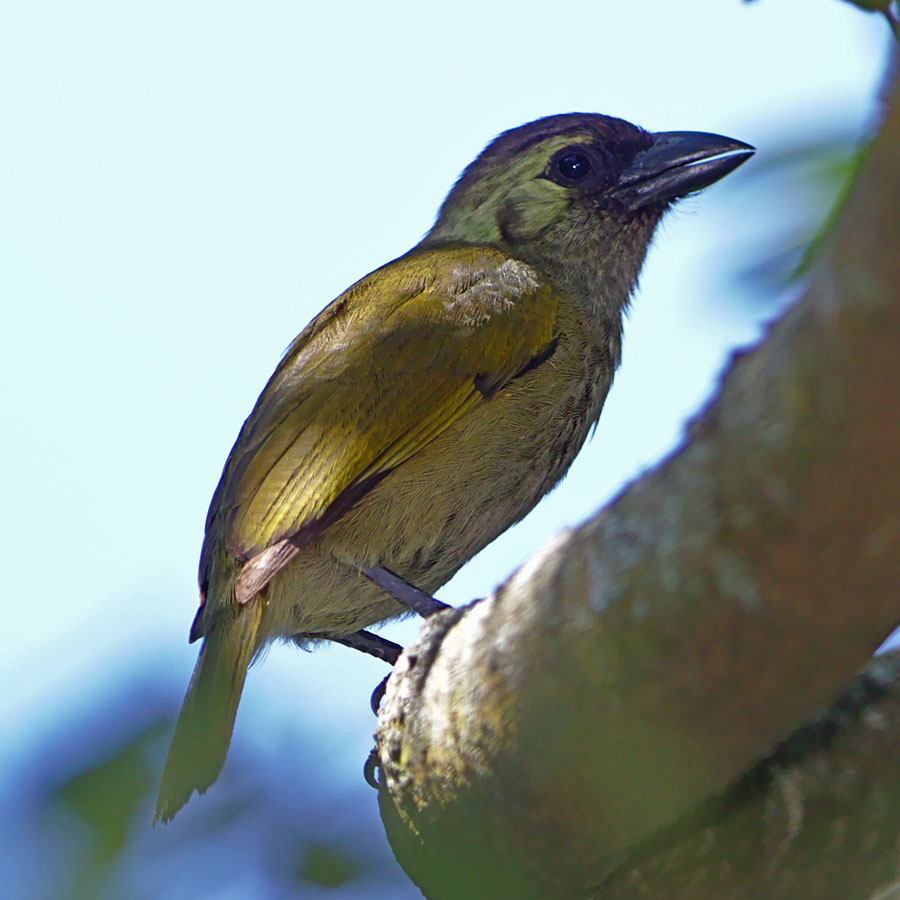
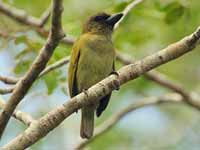
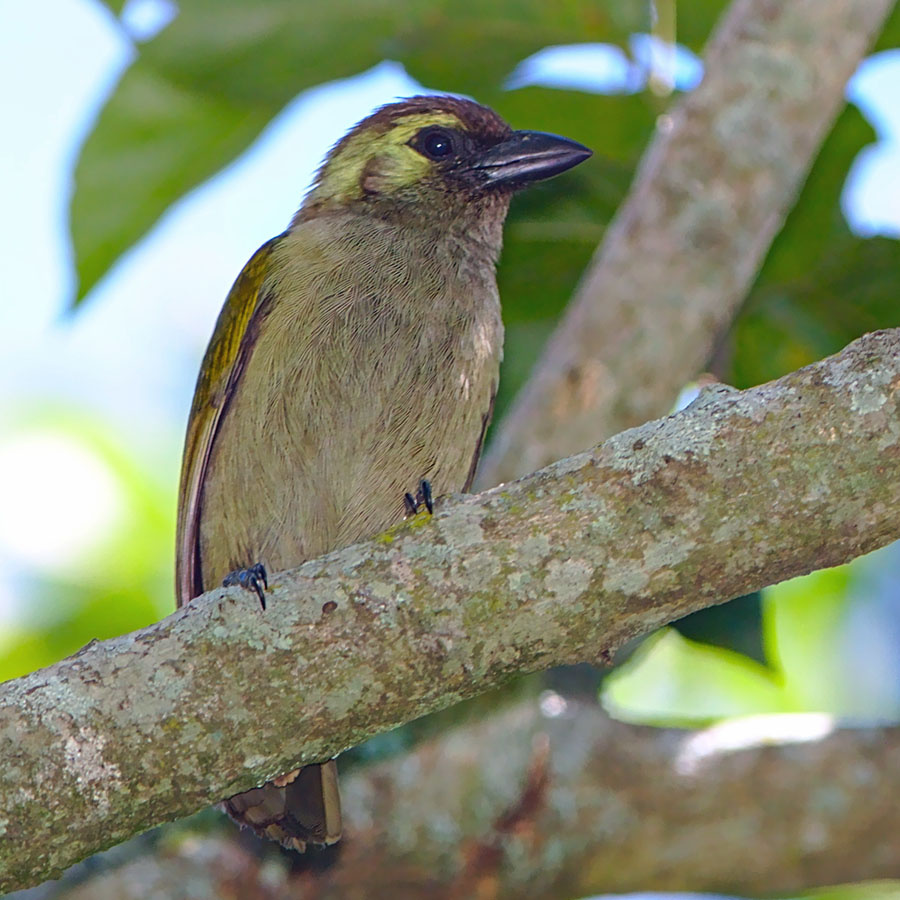
Barbet,_White-eared Stactolaema leucotis
Description: The white-eared barbet has dark brown upperparts with a substantial white stripe around the ear coverts. The throat and breast are also dark brown while the belly is white. The white-eared barbet is 17 to 18 cm long.
Range: Eastern Africa from Tanzania to South Africa
Habitat: Various types of forest - dense or open. Also gardens where fruit is available.
Diet: Fruit, berries. It gleans or hawks for insects.
Conservation status: Least Concern.
Image by: 1, 2, 3) Dick Daniels - South Africa 4) Johan_van_Rensburg - South AfricaRange: Eastern Africa from Tanzania to South Africa
Habitat: Various types of forest - dense or open. Also gardens where fruit is available.
Diet: Fruit, berries. It gleans or hawks for insects.
Conservation status: Least Concern.
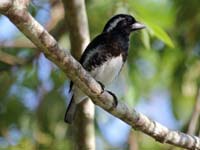
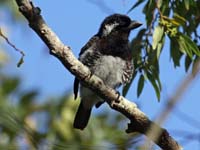
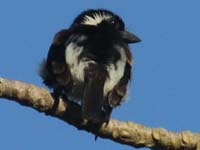

Barbet,_Whyte's Stactolaema whytii
Description: The Whyte's barbet has brown upperparts with white on the wings. It has a black crown with white speckles, some green on the face, and broad white arc below the eyes. The breast is blackish with white spots, the belly white, and the flanks are reddish brown. The Whyte's barbet is about 19 cm long.
Range: Malawi, Mozambique, Tanzania, Zambia, Zimbabwe.
Habitat: Woodlands plus their edges and clearings, gardens with fruit available.
Diet: Fruit, berries, insects.
Conservation status: Least Concern.
Image by: 1) Peter_Steward 2) Nik_Borrow - MalawiRange: Malawi, Mozambique, Tanzania, Zambia, Zimbabwe.
Habitat: Woodlands plus their edges and clearings, gardens with fruit available.
Diet: Fruit, berries, insects.
Conservation status: Least Concern.
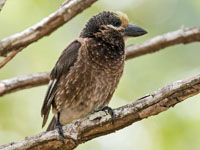
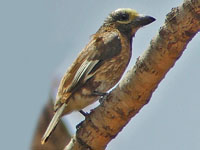
Genus Trachyphonus
These barbets are more terrestrial than most. While some nest in tree cavities, others create earthen tunnels. Most of these species prefer open areas with a few trees and forage on the ground as well as in trees. They all have a conservation status of Least Concern.
Barbet,_d'Arnaud's Trachyphonus darnaudii
Description: The d'Arnaud's barbet has brown upperparts, including the tail, with white speckles. The head is speckled with orange and yellow; some subspecies have a black patch on the crown. The underparts are mostly yellow with a small black throat patch and a thin black breast-band. The d'Arnaud's barbet creates a vertical tunnel two to three feet into the ground that has a sideways and upward turn leading to the nest chamber. In a striking dance the male and female face each on nearby twigs and twitch, bob and sing like mechanical toys. It is 18 to 19 cm long.
Range: East Africa.
Habitat: Insects, fruits, seeds. It will forage on the ground or low in trees.
Diet: Insects, fruits, and seeds.
Conservation status: Least Concern.
Image by: 1) Nik_Borrow - Ethiopia 2) Dipali_Lath 3) David_Bygott - Tanzania 4) Doug Janson Range: East Africa.
Habitat: Insects, fruits, seeds. It will forage on the ground or low in trees.
Diet: Insects, fruits, and seeds.
Conservation status: Least Concern.
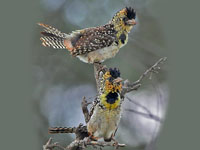

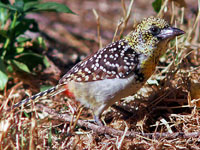
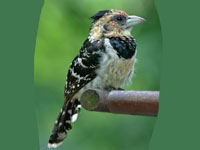
Barbet,_Crested Trachyphonus vaillantii
Description: The crested barbet has black and white upperparts. It has a black crest and a black breast-band. Its speckled face is yellow and red. The belly is yellow with red speckles, They are very vocal, the call being a trill that can continue for long periods. The nest is excavated in a dead tree, dead branch, or in a log. The crested barbet is 22 to 23 cm long.
Range: Sub-Saharan Africa.
Habitat: Woodlands, especially near termite mounds.
Diet: Fruits, insects, other bird's eggs.
Conservation status: Least Concern.
Image by: 1) Axel Bührmann - South Africa 2) Arno Meintjes 3) Jenny Varley - Tanzania 4) Greg Tee Range: Sub-Saharan Africa.
Habitat: Woodlands, especially near termite mounds.
Diet: Fruits, insects, other bird's eggs.
Conservation status: Least Concern.


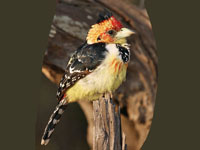
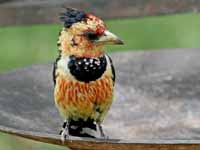
Barbet,_Hairy-breasted Tricholaema hirsuta
Description: The male hairy-breasted barbet has black upperparts with yellow spots on the back and yellow bars on the rump. It has a brown-black tail, black throat, black bill, and grey legs. There is a white supercilium and a white malar stripe. The underparts are yellow with black marking. The female's underparts are more yellow. The hairy-breasted barbet is 17 to 18 cm long.
Range: Central Africa.
Habitat: Tropical rainforest.
Diet: Fruits, berries, insects.
Conservation status: Least Concern.
Image by: 1) William_Swainson 2) Steve_Garvie - Kenya 3) Nik_Borrow - GhanaRange: Central Africa.
Habitat: Tropical rainforest.
Diet: Fruits, berries, insects.
Conservation status: Least Concern.


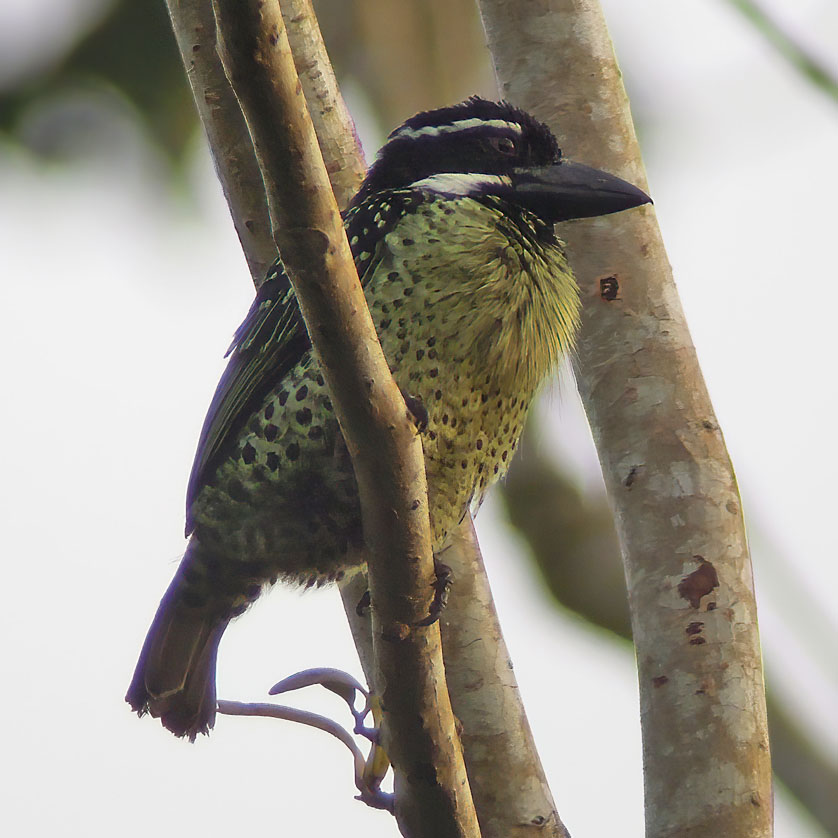
Barbet,_Miombo_Pied Tricholaema frontata
Description: The Miombo pied barbet has a black back with yellow spots, a brown-black tail, and a black head with red spots on the fore-crown. There is white scalloping on nape, brown ear coverts, a yellow supercilium, white chin, white throat, pale grey under-tail, dark brown eyes, and a mostly brown bill. It has a yellow breast and white belly, both with black spots. The nest is a cavity excavated in a tree or stub, The Miombo pied barbet is about 16 cm long.
Range: Angola, DR Congo, Malawi, Tanzania, Zambia.
Habitat: Dense miombo woodland, degraded woodland, grasslands with trees available.
Diet: Fruits, insects.
Conservation status: Least Concern.
Image by: 1) P_Khoo 2) Nigel_Voaden - DR Congo 3) Nik_Borrow - ZambiaRange: Angola, DR Congo, Malawi, Tanzania, Zambia.
Habitat: Dense miombo woodland, degraded woodland, grasslands with trees available.
Diet: Fruits, insects.
Conservation status: Least Concern.
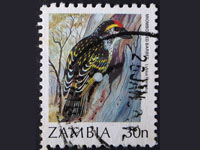

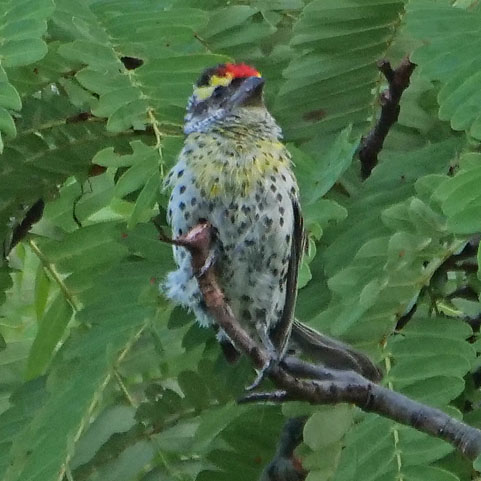
Barbet,_Red-and-yellow Trachyphonus erythrocephalus
Description: The male red-and-yellow barbet has a black back with white spots. It has a black median crown, red and orange nape with black spots, red face, and a blackish-brown tail with cream spots. The upper-breast is red-orange with a dark breast band. The lower-breast and belly are yellow. The female is similar but duller with less red and orange. It nests in tunnels. The red-and-yellow barbet is 22 to 23 cm long.
Range: Eastern Africa.
Habitat: Open woodlands, rivers, cliffs, areas near termite mounds.
Diet: Seeds, fruits, invertebrates.
Conservation status: Least Concern.
Image by: 1, 4) Nik_Borrow - Ethiopia 2) Darren Bellerby - Jurong Bird Park, Singapore 3) Peter_Steward - Kenya Range: Eastern Africa.
Habitat: Open woodlands, rivers, cliffs, areas near termite mounds.
Diet: Seeds, fruits, invertebrates.
Conservation status: Least Concern.

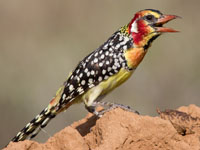

Barbet,_Usambiro Trachyphonus usambiro
Description: The Usambiro barbet has black upperparts with white spots. The head is yellow with black spots and the wings are black with white spots. It has a spotted yellow upper-breast, below which is a black breast-band. The belly is pale yellow. The Usambiro barbet is 18 to 19 cm long. It used to be a subspecies of the D'Arnaund's barbet. The Usambiro has longer wings, a shorter tail, and a darker bill.
Range: Kenya, Tanzania.
Habitat: Open areas including savannah, grassland, shrubland and pastures.
Diet: Seeds, fruit, insects.
Conservation status: Least Concern.
Image by: 1) Neil Strickland 2) Nik_Borrow - Tanzania 3) Francesco_Veronesi - KenyaRange: Kenya, Tanzania.
Habitat: Open areas including savannah, grassland, shrubland and pastures.
Diet: Seeds, fruit, insects.
Conservation status: Least Concern.
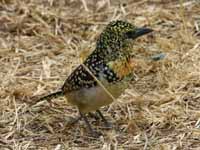
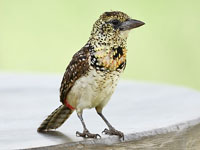
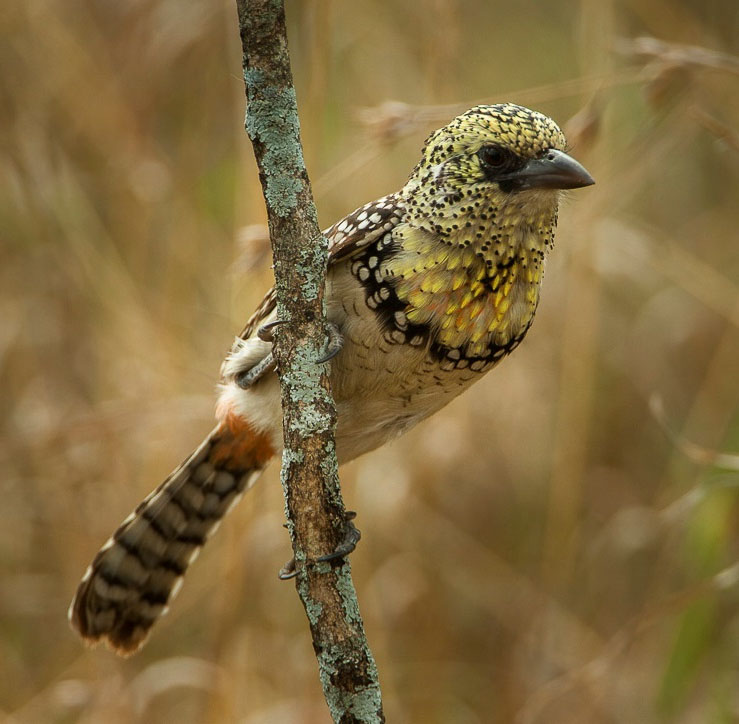
Barbet,_Yellow-billed Trachyphonus purpuratus
Description: The yellow-billed barbet has bluish-black upperparts including the head. The black throat and upper-breast have faint pale streaks. The rest of the underparts are yellow, except the flanks also have some black. The yellow-billed barbet is 23 to 24 cm long.
Range: Central Africa.
Habitat: Forest edges and clearings, more open area with some tall trees available.
Diet: Fruits, insects, snails.
Conservation status: Least Concern.
Image by: 1) Steve Garvie - Kenya 2) Michael and Helen Cox 3) Nik_Borrow - UgandaRange: Central Africa.
Habitat: Forest edges and clearings, more open area with some tall trees available.
Diet: Fruits, insects, snails.
Conservation status: Least Concern.
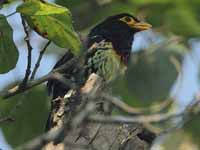


Barbet,_Yellow-breasted Trachyphonus margaritatus
Description: The yellow-breasted barbet has black (which fades to brown) upperparts with white speckles. The head is yellow except for a black cap and a small white patch near the ear-coverts. It has a yellow throat and breast. There is a thin black breast-band above the white belly. A tunnel is excavated for the nest cavity. The yellow-breasted barbet is about 21 cm long.
Range: Central Africa.
Habitat: Lightly wooded areas. Often found in sandy locals for ease of nest excavation.
Diet: Fruit, berries, insects.
Conservation status: Least Concern.
Image by: 1) P_Khoo 2, 3) Nik_Borrow - Ethiopia, DjiboutiRange: Central Africa.
Habitat: Lightly wooded areas. Often found in sandy locals for ease of nest excavation.
Diet: Fruit, berries, insects.
Conservation status: Least Concern.



Genus Tricholaema
Barbet,_Black-throated Tricholaema melanocephala
Description: The black-throated barbet has black upperparts with yellow and white feather edges. It has a black crown, broad white supercilium, wide black mask, and white cheek. The throat is black and that black continues down the center of its underparts. The rest of the underparts are white. This is a small barbet - 12 to 13 cm long. It creates its nest cavity in a tree, often on the underside of a branch.
Range: Eastern Africa.
Habitat: Dry woodland and even desert with some cover.
Diet: Insects and fruit. Insects captured by gleaning or hawking.
Conservation status: Least Concern.
Image by: 1, 3) Nik Borrow - Ethiopia 2) Peter_Steward - KenyaRange: Eastern Africa.
Habitat: Dry woodland and even desert with some cover.
Diet: Insects and fruit. Insects captured by gleaning or hawking.
Conservation status: Least Concern.



Barbet,_Pied Tricholaema leucomelas
Description: The pied barbet, also known as the acacia pied barbet, has a black and white striped head with red forehead and yellow coloring above the eyes. It has a small black bib and white underparts. It creates a nest cavity in the dead wood of a tree. The pied barbet is about 17 cm long.
Range: Southern Africa.
Habitat: Semi-arid savanna, as well as grassland, agricultural areas and urban gardens.
Diet: Fruit, insects.
Conservation status: Least Concern.
Image by: 1, 2) Francesco Veronesi - Etosha Namibia 3) Hans_Hillewaert - Nambiai 4) Bernard_Dupont - South AfricaRange: Southern Africa.
Habitat: Semi-arid savanna, as well as grassland, agricultural areas and urban gardens.
Diet: Fruit, insects.
Conservation status: Least Concern.




Barbet,_Red-fronted Tricholaema diademata
Description: The red-fronted barbet has black upperparts with yellow and white marks. It has a black median crown streak, broad white supercilium, black eye-line, and red forehead. The underparts including the throat are white with the flanks having some black markings. Its nest is excavated in a tree branch. The red-fronted barbet is 17 cm long.
Range: Ethiopia, Kenya, South Sudan, Tanzania, and Uganda.
Habitat: Woodland, grassland with trees or brush available.
Diet: Fruit, seeds, insects.
Conservation status: Least Concern.
Image by: 1)
David Bygott - Tanzania 2) Charles J Sharp - Kenya 3) Dominic_Sherony - Tanzania 4) Nik_Borrow - TanzaniaRange: Ethiopia, Kenya, South Sudan, Tanzania, and Uganda.
Habitat: Woodland, grassland with trees or brush available.
Diet: Fruit, seeds, insects.
Conservation status: Least Concern.
1) Agressive during banding!




Barbet,_Spot-flanked Tricholaema lacrymosa
Description: The spot-flanked barbet has black upperparts, The wings have yellow edges. It has a black median crown streak, broad white supercilium, and black eye-line. It has a black throat. The underparts are whitish with the flanks having black spots. Its nest is excavated in a tree branch or trunk of a dead tree. The spot-flanked barbet is 13 to 14 cm long.
Range: East-central Africa.
Habitat: Open woodlands and gardens, favoring wet areas.
Diet: Fruits, berries, insects.
Conservation status: Least Concern.
Image by: 1) Dick Daniels - specimen in Nairobi National Museum, Kenya 2, 3) Carol Foil - Kenya 4) Francesco_VeronesiRange: East-central Africa.
Habitat: Open woodlands and gardens, favoring wet areas.
Diet: Fruits, berries, insects.
Conservation status: Least Concern.



